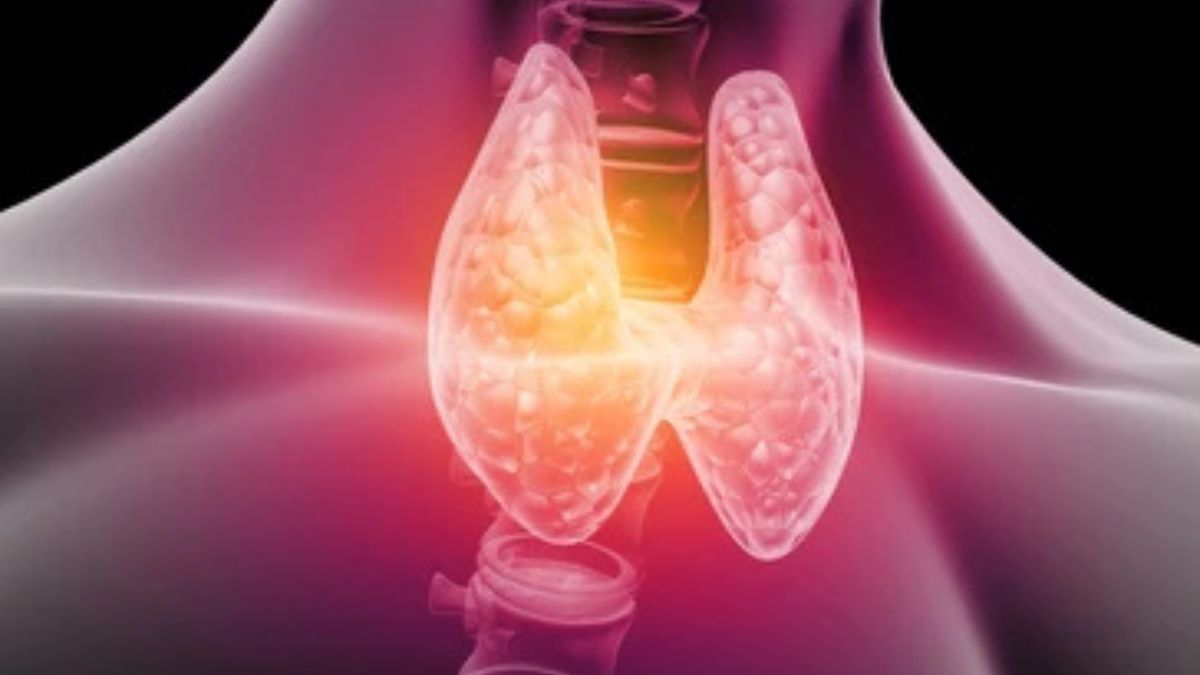HEALTH
Managing Thyroid Health: Insights and Practical Tips

What is the Thyroid Gland, and What Is Its Function?
The thyroid gland is a gland that is small and has the shape of a butterfly, situated at the bottom of the neck. Even though it is small, it plays a crucial function in controlling different metabolic processes in the body by creating thyroid hormones. These hormones, primarily thyroxine (T4) and triiodothyronine (T3) influence heart rate, body temperature, and the rate at which calories are burned, affecting overall energy and metabolism. Maintaining balanced physiological processes requires the thyroid to function properly.
Common Thyroid Symptoms
The symptoms of thyroid problems can differ greatly depending on if the thyroid is underactive (hypothyroidism) or overactive (hyperthyroidism). Frequent signs of hypothyroidism consist of enduring tiredness, gaining weight, experiencing constipation, having dry skin, and being sensitive to cold. On the other hand, hyperthyroidism could present with involuntary weight reduction, nervousness, restlessness, quick or irregular heart rate, and inability to tolerate heat. Identifying these signs early is essential, as both illnesses can result in severe health issues if not addressed. Regular check-ups and awareness of these signs can make a significant difference in managing thyroid health effectively. If you’re curious to learn more about thyroid symptoms, you might find helpful information from a thyroid specialist.
The Importance Of Monitoring Thyroid Health
It is essential to regularly monitor thyroid function with blood tests and professional consultations. Testing typically includes measuring thyroid-stimulating hormone (TSH), T4, and T3 levels to assess how well the thyroid functions. Detecting and treating thyroid issues promptly can help avoid problems and greatly enhance quality of life. If you have symptoms linked to thyroid issues, it’s important to see a healthcare provider for a complete assessment and correct diagnosis. Addressing thyroid issues promptly can aid in maintaining better overall health and avoiding secondary health problems related to thyroid imbalance.
Impact Of Diet On Thyroid Health
A balanced diet plays a significant role in maintaining thyroid health. Certain nutrients such as iodine, selenium, and zinc are vital for adequately producing and regulating thyroid hormones. Iodine in foods like seafood and dairy is essential for thyroid hormone synthesis. Selenium, abundant in Brazil nuts and sunflower seeds, helps protect the thyroid gland from oxidative damage and supports hormone metabolism. Zinc is crucial for hormone production and immune function in meat and legumes. Incorporating these nutrient-rich foods into your diet can be beneficial. However, be cautious with goitrogenic foods like broccoli, cabbage, and soy, which, in excessive amounts, can interfere with thyroid function by inhibiting iodine absorption.
Dietary Tips for Thyroid Health
- Include iodine-rich foods such as fish and dairy.
- Eat selenium-rich foods like Brazil nuts and sunflower seeds.
- Incorporate zinc sources like meat and legumes.
- Limit consumption of goitrogenic foods such as cabbage and broccoli.
Exercise And Thyroid Health
Engaging in consistent exercise can aid in weight control and enhance overall health, promoting optimal thyroid function. It is suggested to engage in mild physical activities like walking, swimming, and yoga to improve heart health, build muscle strength, and promote mental calmness. Regular exercise can also aid in reducing stress levels, which is essential for those with thyroid issues. High-stress levels can exacerbate thyroid problems, leading to a vicious cycle of worsening symptoms. According to Harvard Health, physical activity can be an effective strategy for managing stress and promoting relaxation, which is particularly beneficial for thyroid health.
Lifestyle Changes To Support Thyroid Health
Beyond diet and exercise, other lifestyle changes can positively impact thyroid health. Ensuring adequate sleep, with a target of 7-9 hours per night, helps regulate hormones and supports overall health. Utilizing methods like meditation, deep breathing exercises, or yoga can help manage stress and lessen its negative impact on the thyroid. It is crucial to steer clear of smoking and restrict alcohol consumption, since these substances can have a harmful impact on thyroid function. Keeping yourself properly hydrated by drinking an ample amount of water is another uncomplicated but efficient method to promote thyroid health and general wellness.
Simple Lifestyle Changes
- Get 7-9 hours of sleep each night.
- Engage in stress management methods such as mindfulness and yoga.
- Avoid smoking and limit alcohol intake.
- Stay hydrated by drinking plenty of water.
Natural Remedies And Supplements
While some natural remedies and supplements claim to support thyroid health, it is essential to approach these with caution. Natural supplements such as ashwagandha, an adaptogen that can help manage stress, and supplements like selenium and Vitamin D, which support immune function and hormone production, can be beneficial under the guidance of a healthcare professional. Always be sure to seek advice from a healthcare professional prior to beginning any new supplement regimen. Professional guidance is essential to ensure safety and effectiveness when managing thyroid health, as certain individuals may experience interactions with medications or unintended side effects.
Popular Supplements
- Vitamin D: Supports immune function and overall health.
- Selenium: Essential mineral for thyroid hormone production.
- Ashwagandha: An adaptogen that can help manage stress.
When To Seek Professional Help
If you suspect a thyroid issue, it’s essential to seek professional help. Endocrinologists specialize in hormone-related conditions and can provide tailored treatment plans that address specific thyroid issues. Symptoms like unexplained weight changes, persistent fatigue, or swelling in the neck should not be ignored. Timely intervention and proper treatment can stop the progression of symptoms and complications, leading to improved management of thyroid issues and enhanced overall well-being.
HEALTH
Milestones Achieved with PT

The milestones achieved through physical therapy often mark significant turning points in patients’ lives. These moments of progress inspire both patients and therapists alike:
- Walking Again After an Injury: A patient recovering from a severe ankle sprain celebrated the moment they walked unaided for the first time, a milestone made possible through dedication to their PT program.
- Returning to Work: For individuals with physically demanding jobs, regaining strength and endurance through PT means returning to their careers with confidence and capability.
- Competing in Sports Post-Rehabilitation: Athletes recovering from injuries achieve milestones like running their first race or competing in their sport again, thanks to customized rehabilitation plans.
If you’re looking for trusted professionals to help you achieve your goals, consider physical therapy Norman OK for comprehensive care and support.
For those seeking additional options, finding physical therapists near me ensures you’re working with experienced providers ready to guide you toward your own success story.
Start Your Journey to Success
Physical therapy has the power to change lives by addressing pain, improving mobility, and empowering patients to achieve incredible milestones. Whether you’re recovering from an injury, managing a chronic condition, or looking to enhance your athletic performance, PT offers a proven path to progress.
Take inspiration from these success stories and begin your journey today. With expert guidance and dedication, you too can achieve life-changing results through physical therapy.
HEALTH
Dr. Richard McDonnell Kansas City: A Pillar of the Medical Community

Kansas City is renowned for its vibrant culture, community-driven ethos, and cutting-edge developments in various fields – including healthcare. At the heart of this medical excellence stands Dr. Richard McDonnell Kansas City, a true pillar of the Kansas City medical community. With decades of dedication and countless contributions, Dr. McDonnell has earned a legacy of trust, innovation, and compassion.
This blog dives into the inspiring story of Dr. McDonnell, exploring his background, his key contributions to the community, and why his work continues to make a lasting difference.
A Brief Biography of Dr. Richard McDonnell
Born and raised in the Midwest, Dr. Richard McDonnell pursued medicine with a passion that stemmed from a deeply rooted desire to improve the lives of others. After earning his medical degree from a prestigious institution, Dr. McDonnell continued his medical training at leading hospitals and research centers, specializing in internal medicine and community health.
Through a combination of determination, empathy, and unmatched expertise, Dr. McDonnell became a prominent figure in Kansas City’s medical circles. His work touches nearly every corner of healthcare, from patient care to education and advocacy.
Key Milestones and Achievements
- Clinical Excellence: Dr. McDonnell has spent over 25 years providing top-tier clinical care, earning recognition for his diagnostic precision and patient-focused approach.
- Academic Contributions: A lifelong learner and teacher, he has mentored young physicians and contributed to medical publications to advance the collective knowledge of his field.
- Advocacy and Community Initiatives: Dr. McDonnell actively works to promote accessible healthcare for underserved populations in Kansas City, extending his support to numerous local health initiatives.
Dr. McDonnell’s Contributions to Kansas City Healthcare
Dr. McDonnell’s contributions go far beyond the examination room. Below are the key ways he’s helped shape the medical community:
1. Elevating Standards in Patient Care
Dr. McDonnell is celebrated for his empathetic approach to treating patients. Known for his ability to listen attentively and provide tailored treatment plans, his practice has become a beacon of patient-centered care in the Kansas City area. His philosophy emphasizes understanding the individual as a whole rather than focusing solely on their symptoms.
Impact in Numbers:
- Serves hundreds of patients yearly, many of whom report higher satisfaction and better long-term health outcomes under his care.
- Played a role in implementing new diagnostic tools, streamlining patient processes, and reducing time-to-treatment in clinical settings.
2. Pioneering Health Education Programs
Dr. McDonnell firmly believes in the power of education. He has partnered with local institutions to establish health workshops and educational programs designed to empower Kansas City residents to take control of their health. These programs focus on preventive measures, such as nutrition, exercise, and regular health screenings.
Some notable initiatives include:
- Public seminars on cardiovascular health and diabetes management.
- High school outreach programs that inspire future health professionals.
3. Advancing Medical Research
Beyond patient care, Dr. McDonnell has been involved in groundbreaking research projects aimed at improving diagnostic methods and treatment protocols for common diseases. His clinical trials and partnership with research universities in Kansas City have resulted in innovations that benefit patients nationally.
Dr. McDonnell’s key research interests include:
- Chronic disease management, specifically Type 2 diabetes and hypertension.
- Innovations in telehealth to expand access to care for rural populations.
4. Bridging Healthcare Gaps in Kansas City
Kansas City is not immune to the issue of healthcare disparities. Dr. McDonnell has played a significant role in addressing these issues by working with nonprofit organizations and local clinics to bring care to underserved communities. He’s led volunteer groups that offer free medical check-ups, vaccinations, and health education across vulnerable neighborhoods.
5. Mentoring Future Generations
Dr. McDonnell’s influence extends to his role as a mentor. He collaborates with universities and residency programs across Kansas City, sharing his knowledge with aspiring doctors. His emphasis on ethical, empathetic medicine has inspired countless young physicians to follow in his footsteps.
Why Dr. McDonnell’s Work Matters
Dr. McDonnell’s tireless efforts serve as a reminder of how individuals can profoundly affect their communities. His work addresses critical healthcare challenges, including:
- Preventive Care Awareness: Helping people adopt healthier lifestyles to avoid chronic diseases.
- Health Equity: Bringing quality healthcare to all demographics, regardless of socioeconomic status.
- Community Resilience: Inspiring local partnerships to create a more robust, patient-focused healthcare system.
The Future of Healthcare in Kansas City, Inspired by Dr. McDonnell
The legacy of Dr. Richard McDonnell Kansas City acts as a blueprint for the future of healthcare innovation in Kansas City. By focusing on community, education, and research, Kansas City can continue to raise the bar for medical excellence.
Whether working with patients directly or inspiring systemic change, Dr. McDonnell’s forward-thinking approach ensures a healthier, more connected Kansas City for future generations.
Final Thoughts
Dr. Richard McDonnell Kansas City name is synonymous with innovation, care, and community. His endless efforts—a perfect blend of compassion and science—continue to promote wellness and progress for thousands of individuals across Kansas City.
Want to stay updated on impactful figures in healthcare like Dr. McDonnell? We share stories, insights, and tips to help you take control of your health and thrive. Subscribe to our newsletter or explore more inspiring stories on our blog.
HEALTH
Finding the Ideal Elderly Care Provider for Your Loved One

Selecting the right elderly care provider involves assessing medical needs, personal preferences, and lifestyle compatibility. Key considerations include staff qualifications, available services, and the facility’s reputation. Visiting potential providers, asking detailed questions, and seeking recommendations can help ensure a supportive and nurturing environment, promoting well-being and comfort for your loved one.
Introduction
Empathy, love, and responsibility motivate us to ensure our loved ones receive the finest care possible as they age. Selecting the right elderly care provider involves navigating a complex landscape of diverse options and emotional stakes. This decision is crucial as it impacts not just the well-being of the loved one but also the peace of mind of the entire family. When considering professional services through avenues like elderly care Missouri or anywhere else, the emphasis should always be on careful planning and informed assessments. This article offers a comprehensive guide to uncovering the facets of elderly care, equipping you with insights necessary for making a choice grounded in your family’s unique needs and circumstances.
Understanding Your Needs
To choose the best senior care provider, it’s crucial to understand your loved one’s unique needs, including daily routines, personal preferences, and emotional well-being. This helps define the care structure and create a personalized plan to enhance their daily life quality. This understanding ensures that every decision aligns with their comfort, dignity, and security, making it a customized blueprint for improving their quality of life.
Types of Elderly Care Services
In-Home Care
In-home care is popular for seniors who value their comfort and familiarity as they age. It allows them to stay in their loved home while receiving personalized services. Caregivers assist with household chores, personal care, and medical tasks, fostering independence and continuity. This familiar environment significantly contributes to well-being as professionals adapt to evolving needs.
Assisted Living Facilities
Assisted living centers are ideal for elderly individuals who enjoy routine activities and social interaction. They provide a supportive environment, encouraging residents to engage in activities, develop friendships, and participate in community events. These facilities foster an active lifestyle while ensuring safety and support, allowing seniors to enjoy their time with fewer responsibilities. This level of engagement is particularly beneficial for those who enjoy peer company and organized activities.
Evaluating Caregiver Credentials
Entrusting the care of a loved one to another demands confidence in that individual’s capabilities, thus making it imperative to evaluate their credentials thoroughly. Check for formal certifications, professional training, and relevant experience in elderly care. Talking to references, particularly from families who have previously employed the caregiver, can provide firsthand insight into their reliability and competence. It’s wise to consult detailed guides, such as the one from the Senior Living Caregiving Guide, highlighting key attributes to seek in potential caregivers. These steps help ensure the caregiver possesses the skills needed for daily tasks and the sensitivity and emergency preparedness essential in caregiving roles.
Financial Considerations
Financial planning is an essential component in the decision-making process for elderly care. Understanding the costs of various options helps prevent unexpected expenses and ensures sustainable care. Investigate different cost structures, considering what aligns best with your financial capabilities. This includes checking possibilities for insurance coverage, government support, and any available community resources or subsidies. Addressing financial considerations simplifies long-term planning, allowing you to focus on maintaining consistent care quality rather than navigating financial strains.
Using Technology to Aid Care
Technology is pivotal in transforming how elderly care is delivered today. Innovative tools, such as wearable health monitors and medication management apps, enhance the safety and efficiency of care. These advancements enable real-time monitoring of vital signs, allowing caregivers and family members to respond swiftly to any changes. Utilizing technology in care not only aids in routine tasks but also provides peace of mind by facilitating constant communication and updates. Keeping up-to-date with the latest advancements in elderly care technology empowers families to harness these tools, optimizing the overall care experience while reducing the burdens on both the caregiver and care recipient.
Conducting Interviews with Potential Caregivers
Interviews are crucial for assessing a caregiver’s suitability beyond their professional qualifications. They should cover their experiences, problem-solving skills, and handling of critical situations. The interviews should also evaluate their interpersonal skills, communication style, and attitudes toward caregiving roles. These personal exchanges complement formal credentials, providing insight into the caregiver’s suitability and compatibility, which is vital for a successful caregiving arrangement.
Trial Periods and Monitoring
Implementing a trial period allows families to evaluate the suitability of a caregiver in real-world conditions. During this phase, monitor their interactions closely, looking for signs of rapport and adaptability to your loved one’s needs. Engage in open discussions with your loved one to understand their level of comfort and satisfaction. This trial period allows the caregiver and the family to make necessary adjustments, ensuring both parties are satisfied. Regular feedback and communication during this time can significantly fine-tune the caregiving arrangements to enhance mutual trust and assurance.
Long-Term Planning
Proactive long-term planning helps navigate health and personal preference shifts in your loved one’s care. Regularly re-evaluate the care arrangement to adapt to new medical needs, emotional changes, or lifestyle wishes. This approach ensures a high quality of life by maintaining consistency with evolving requirements. It is crucial for providing continuous quality care, meeting immediate needs, and preparing for future developments.
-

 BLOG8 months ago
BLOG8 months agoTribute Printed Pics: Top 10 Ways to Honor Loved Ones
-

 NEWS7 months ago
NEWS7 months agoNEWS JoTechGeeks: How to Stay Updated with the Latest News
-

 BLOG5 months ago
BLOG5 months agoThe //Vital-Mag.net Blog: Your Daily Dose of Inspiration
-

 ENTERTAINMENT8 months ago
ENTERTAINMENT8 months agoFreemoviesfull.cc: Ultimate Guide
-

 HEALTH8 months ago
HEALTH8 months ago2023-1954: Enhancing Health and Vitality
-

 TECH8 months ago
TECH8 months agoWww abithelp .com: Your Ultimate Online Assistance Platform
-

 HEALTH8 months ago
HEALTH8 months agowww healthsciencesforumcom: A Trusted Health Sciences Platform
-

 TECH8 months ago
TECH8 months agoWebtoon XYZ: A Journey into the World of Digital Comics
